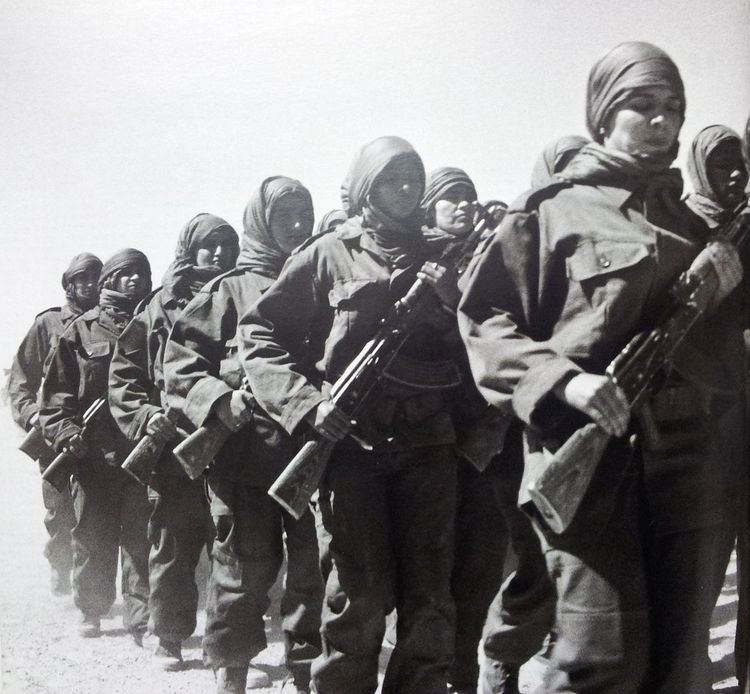Unknown Lahbib Ayub | Unknown Unknown | |
 | ||
14 killed, 31 wounded (Morocco claim) 80 killed and wounded (Morocco claim) | ||
The 1989 Battle of Guelta Zemmur took part on 7 October 1989, when POLISARIO guerrillas commanded by Lahbib Ayub attacked the Moroccan Wall on the Guelta Zemmur section. The attack was the bigger battle in the war since 1988, as the Polisario Front saw the negotiations with Morocco on a dead end. Hassan II reacted to the Sahrawi offensive denying a second encounter with the POLISARIO leaders. According to the Spanish newspaper El País, at least a hundred soldiers from both sides were killed in the clashes.
Contents
The portions of Western Sahara was a Spanish Colony till 1975 as the last colonial province in Africa. A war erupted between those countries and the Sahrawi national liberation movement, the Polisario Front, which proclaimed the Sahrawi Arab Democratic Republic (SADR) with a government in exile in Tindouf, Algeria. Mauritania withdrew in 1979, and Morocco eventually secured control of most of the territory, including all the major cities and natural resources. Continued war was waged between Polisario and Morocco over prominence in the region backed by Algeria for Polisario and US, France and Saudi Arabia for Morocco. The UN peace mission aiming a ceasefire and a referendum was accepted in various degrees by both the fighting parties. The war was fought at a moment when Polisario felt that the second peace talks were deliberately delayed by King Hassan of Morocco. As an aftermath, the peace talks were called off.
Background
The portions of Western Sahara was a Spanish Colony till 1975 as the last colonial province in Africa. A war erupted between those countries and the Sahrawi national liberation movement, the Polisario Front, which proclaimed the Sahrawi Arab Democratic Republic (SADR) with a government in exile in Tindouf, Algeria. Mauritania withdrew in 1979, and Morocco eventually secured control of most of the territory, including all the major cities and natural resources.
Morocco built fortified sand walls in the North Western border towards Western Sahara. Polisario attacked the base at Guelta Zemmour. While Polisario was advancing during most of the offensive, Morocco overpowered them subsequently. Morocco removed the wall, but the wars continued for more than a decade subsequently.
History
Polisario was formed in 1973 to fight for the rights of Sahawari Arab African People. The earlier attack in the same region was during 13 October 1981, which lasted for ten days and considered one of the major offensive during the war period. Polisario had 3,000 troops and was up against a Moroccan army of 2,600. Polisario used T-54 and T-55 tanks and SA-6 surface-to-air missiles. SA-6 was an addition that paralyzed the Moroccan air force, which had only four Mirage pilots. Two Mirage F-1s , the only C-130 with Moroccan Army and a control platform were shot down. The air force was not in operation in the belt fearing attack from SA-6 and the ground army were left stranded. Polisario had a decisive victory in the war. Morocco started building a massive wall to reduce the attacks and military activity. During November to December 1987 a United Nations peace mission arrived at the location to assess the military and political impact. They sought a face-to-face meeting with Polisario and Morocco to arrive at a ceasefire and initiate proceedings for a referendum. They had different meetings with Morocco, Algeria and Polisario and place a resolution which was passed unopposed. During the time, Algeria, which had been a long time ally of Polisario, held secret meetings with Morocco at foreign ministry level. By May 1988, both the countries announced that diplomatic relations between the countries would be restored. During July 1988, Moroccan King Hassan expressed his support for a referendum, but declined to name it a independent state, but a special administrative region. He also denied meeting with Polasario. In spite of UN's continued effort, the denial introduced fresh attack in Moroccan positions by Polasario. King Hassan agreed to meet representatives from SAWR. During 1989, Algeria claimed that it would continue to support SAWR amidst growing concern of Algeria breaking links with SAWR. King Hassan's elongated delay frustrated SAWR and they started an attack. During the first week of October 1989, Polasario started attacks on Moroccan positions in Guelta-Zemmour, which left the Moroccan troops 25 kilometers inside the defense. The group also claimed that they have secured the 1st Light Security Group of the 4th and 5th Rapid Intervention Force of Morocco. They also attacked Moroccan positions in the North towards Hauza on October 11. Following the attacks King Hassan called off the second meeting with SAWR representatives.
Weapons and support
The Russian built SA-6 was provided to Polisario by Algeria. Historians believe that Moroccan inflow of weapons were at the peak during 1978–80 compared to a steady inflow of arms to Polisario. Morocco received most of its arms from the United States and France, while finances were received from Saudi Arabia. France and the US were running an arms race to market their products, with France taking precedence in selling French Gazelle helicopters, light tanks, armored cars. French were also providing military intelligence and training with their experience in dealing with Sahara. The US administration under Jimmy Carter wanted the Moroccan administration under future condition of reaching a peace accord. But the continued cross border attack by Polisario into Moroccan territory changed the stance of Carter administration, which approved the deal of 200 million dollar worth ground sensor technology in 1979.
